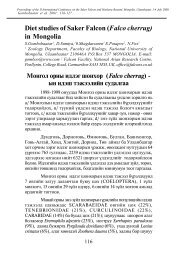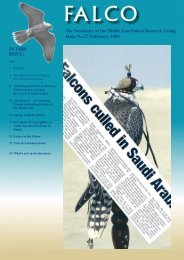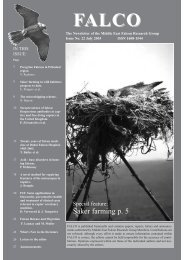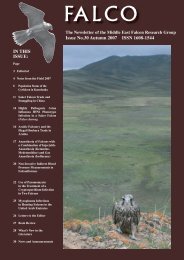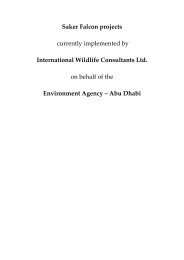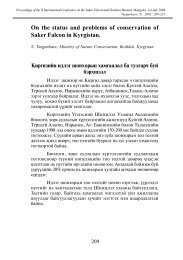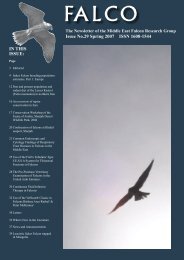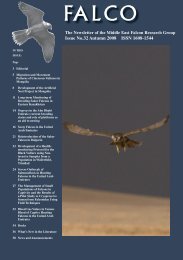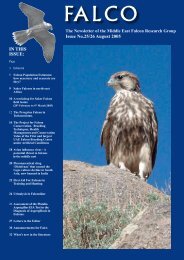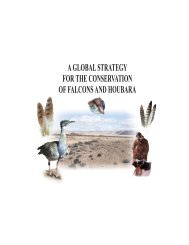falco - International Wildlife Consultants Ltd.
falco - International Wildlife Consultants Ltd.
falco - International Wildlife Consultants Ltd.
You also want an ePaper? Increase the reach of your titles
YUMPU automatically turns print PDFs into web optimized ePapers that Google loves.
First documented clutch and brood of six in SakerFalcon (Falco cherrug).E. Potapov 1 , D. Sumya 2 , S. Gombobaatar 2 , O.Shagdarsuren 2 , S. Tuya 3 , L. Ochirkhuyag 4 & N. Fox 1 .1. The Falcon Research Institute, PO Box 19,Carmarthen SA33 5YL, UK2. Faculty of Biology, Mongolian State University,Ulaanbaatar, Mongolia3. Center for Environmental Remote Sensing, ChibaUniversity, 1-33 Yayoi-cho, Inage-ku, Chiba, 263-8522Japan, E-mail: s.tuya@lycos.com s.tuya@cr.chibau.ac.jp4. The National Remote Sensing Center, TheInformation and Computer Center, Ulaanbaatar-210646, Mongolia, lochir@yahoo.comIntroduction and methodsThe Mongolian programme of the Falcon ResearchInstitute has been running since 1998. The field team hasbeen led during the 5 field seasons by Prof. D. Sumya andMagister S. Gombobaatar under the supervision of Acad.O. Shagdarsuren. The aim of the scientific programme isto study Saker Falcon biology in Mongolia and to providethe Mongolian government with population data, numbersand breeding rates of the Saker populations to be used inestablishing harvesting quotas for <strong>falco</strong>ns in compliancewith CITES regulations.Within study areas, Saker nests were mapped and theirbreeding performance monitored. There were some nestsoutside the study areas which were visited but they werenot used in calculations of population density. Clutch size,which is considered to be one of the most important factorsdetermining a species breeding rate (Newton 1979), aswell as breeding success was determined in as many nestsas possible. In total we have data on 188 clutches/broodsduring the period 1998-2002.difficult.The symmetry of the clutch size distribution was notconstant across the years (Figure 1). An almost symmetricaldistribution was observed in 2001 and 2002 but wasskewed towards smaller clutches in all other years, mostnotably in 2000. During 2002 we found an unexpectedlyhigh proportion of large clutch sizes.Fig. 1. Clutch size variation across years with S.D. Figureson horizontal axis are sample size.Snow cover in Mongolia showed significant variationbetween 2001 and 2002 (ANOVA: F=9.36, F=0.005) asdid clutch size across the years (ANOVA: F=6.68, P=0.01)(Figure 2).Fig. 2. Clutch size variation plotted against % snow cover.We also examined the possible influence of winter snowcover on clutch size. The snow coverage data was analysedusing GIS methods at the Mongolian National RemoteSensing Center of Mongolia. Snow cover in Mongolia hasbeen monitored since 1999 and the snow cover maps arepublished on the website of the Ministry of Nature andEnvironment of Mongolia. A combination of meteorologicalstation measurements and mapped snow distributionwas used to validate and quantify the satellite data.ResultsClutch size in Mongolian Saker <strong>falco</strong>ns (Figure 1) variessignificantly across years (ANOVA: F=9.59 P=0.0000007).Largest clutch sizes were observed in 1999 and 2002. Bothwinters prior to these breeding seasons were characterisedby low winter snow coverage. The winters of 1999/2000and 2000/2001 are known as severe cold and snowy winterswith so-called “zud” conditions. “Zud” conditionsmeans that the ground was covered by ice formed beforesnow cover, thus making grazing by rodents and livestockIn 2001 there was greater snow coverage and smallerclutch sizes. In 2002 the snow cover across Mongolia wasvery unstable and unusually thin. Clutch sizes for 2002were at a maximum for the whole 5 year period. We haverecorded two clutches of 6: six chicks in down in one nestand 6 eggs at a different location 241 km apart.DiscussionA clutch of 6 is very big for large <strong>falco</strong>ns. References on14



